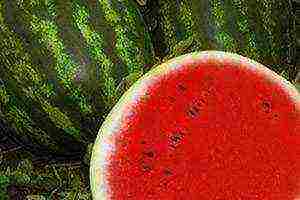Content
- 1 Pavlovsky
- 2 Meyer
- 3 Chinese
- 4 Anniversary
- 5 Genoa
- 6 Lisbon
- 7 Maikop
- 8 Buddha's hand
- 9 Ponderosa
- 10 Volcano
- 11 Lunario
- 12 Novogruzinsky
- 13 Lemon Care Video
- 14 Volcano (Citrofortunella Vulcan)
- 15 Meyer (Beijing)
- 16 Femminello comune
- 17 Cantonese Red Lemon
- 18 Kurskiy (Citrus Kursky)
- 19 Doux de Mediterranea
- 20 Tashkent (Uzbek) lemon
- 21 Melarosa (Citrus limon Mellarosa)
- 22 Vanilla (Limone vaniglia)
- 23 Rosso (Limonimedica Pigmentata)
- 24 Buddha's hand
Have you already grown indoor lemon and decided to add to your collection? Or are you just planning to acquire a similar exotic? Let's see which varieties of lemons are best suited for growing in apartments.
Pavlovsky
Lemon tree about 1.5–2 m high with a small rounded crown up to 1 m. Old branches have gray-green bark with small thorns. Leaves are glossy smooth, dark, up to 16 cm in length. They can be oval, rounded or elongated.
It blooms and bears fruit all year round, one of the most unpretentious varieties to care for. Even western and north-western windows are suitable for such a room lemon. It produces from 20 to 40 tasty fruits per year (many argue that they are even tastier than usual) weighing 120–150 g. Sometimes there are specimens up to 500 g. The peel can be eaten together with the pulp, usually 5–10 seeds, occasionally 20. Often found fruits without seeds. This lemon variety begins to bear fruit at 3-4 years of age.
It is relatively resistant to dry air, but reacts very well to spraying the crown. The ideal humidity for him is 60–80%. In the house, it is usually grown near the eastern windows, although it can tolerate partial shade. Burns are possible on the south window.
Meyer
Widespread for outdoor cultivation, where it is often grafted. In the apartment it is grown on its own roots. The height of the tree is from 1 to 1.5 m. The crown is well leafy and easy to form. There are few thorns. Leaves are glossy, dense and dark, serrated.
Refers to remontant and early ripening varieties, bears fruit abundantly, sometimes up to 4 times a year. Fruits are not very sour, up to 150 g. Buds appear only on young shoots released this year. It blooms earlier than other species, most often already in March or April. The flowers are small (3-4 cm), but very fragrant. They can be located singly or in inflorescences of 2-6 pcs. Ripening lasts 8-9 months, the fruits are removed slightly unripe.
These homemade lemons need to be looked after carefully: in winter they must be kept in a room where the temperature is no more than 12 ° C, otherwise the fruits may not set. They need regular watering and spraying of the crown. It is better to grow such a lemon near the east or west windows: the abundance of light will make the tree grow quickly, but will slow down the setting of flowers. Blackout is also harmful - leaves may begin to fall from it. It is necessary to protect from drafts. Meyer can be grown from both cuttings and seeds.
Chinese
In fact, this is the second name of Meyer's lemon: this variety was brought from Beijing (for which it was named "Chinese") by the researcher Franz Meyer (in whose honor the variety received the first name).
Anniversary
A hybrid bred in Uzbekistan, the "ancestors" of which were such lemon varieties as Tashkent and Novogruzinsky lemon. One of the most undemanding varieties to care for. Lemon Jubilee usually grows up to 1.5 m. It is a large-fruited variety (fruits up to 600 g). The skin is thick. This homemade lemon attracts many with its abundant flowering, during which the tree is almost entirely covered with white flowers with a slightly purple tint (also a "hereditary" feature of the variety from Tashkent). Usually they are collected in inflorescences of 14-16 pcs.
Like the variety bred in Tashkent, it begins to bear fruit for 3-4 years.It adapts quickly and easily tolerates room conditions: even in dry air and with low watering, fruits are set. True, it is difficult to obtain cuttings for propagation from this variety of indoor lemons: branches with buds are formed from almost every bud and leaf sinus.
Genoa
One of the rare species. Trees about a meter with a dense crown. There are almost no thorns. These lemons are distinguished by their particularly tasty fruits with delicate pulp. Their peel is edible, without bitterness.
Rather dense films inside are characteristic. Weight reaches an average of 110 g. The lemon grown from the cuttings begins to bloom in the 4th year. One of the important conditions for care is an abundance of light, without which the tree does not develop well. With good home care, it gives a huge harvest: in the first years of fruiting, it brings up to 50 fruits, and from an adult tree they can be harvested in about 120-180 a year.
Lisbon
Tall trees with large, dense and wide leaves. There are many thorns. The fruits are very tasty, seedless, with a thin edible skin, weighing 120–150 g. Very hardy variety. It develops well at almost any room temperature, it is resistant to heat and cool, as well as drought. Lighting loves bright, but diffused - direct rays of the sun should not fall. As a rule, it begins to bear fruit as early as 2-3 years. From this lemon tree, you can harvest up to 60 pieces in a season.
Maikop
The best varieties have been used for breeding this lemon. The result is an extremely productive crop: mature trees produce 100-300 fruits per year, and sometimes up to 700 are removed from old lemon trees of this variety! The fruits weigh about 140-160 g.
Trees rarely grow taller than 2 meters. They are hardy and unpretentious, home conditions are well suited for them. There are two subspecies. The first type is formed almost without stamping. The crown is dense, branched, with many branches without thorns, which are located horizontally or hang down slightly. Leaves with a waxy bloom, dark. Small flowers are collected in inflorescences of 3-5 pcs. It normally tolerates wintering in houses and ordinary indoor conditions.
The second variety is distinguished by strong, semi-vertical branches directed upwards. The crown is symmetrical. This type easily adapts to home conditions, but prefers wintering in a cool room.
Buddha's hand
If you wanted to know which lemon is the most original, then this is without a doubt the Hand of Buddha. Such indoor lemon is usually obtained for its decorative qualities. Most of all attention is attracted by its fruits: long, up to 40 cm, in the form of a bunch of bananas or a hand (for which the variety got its name). They consist mainly of a thick peel up to 5 cm, the pulp is very little, it is not juicy, has a bitter or very sour taste and is not suitable for eating, however, the zest is sometimes used for baking.
The leaves are oval and rather large. Home care requires plenty of light and warmth. Begins to bear fruit in the 3rd year. The fruits have a slight scent of violets. Sometimes this tree is used in perfumery.
Ponderosa
A hybrid that came naturally from crossing between species such as citrons and lemons (according to some versions, like the New Zealand variety). It has similarities with the Kiev large-fruited. It normally tolerates heat and drought, but before starting such a plant, you need to carefully read the care rules: the plant is sensitive to soil, reacts poorly to its excessive acidity, needs additional fertilizing. These lemon trees love diffused glare.
The trunk is up to 1.8 m. Strong branches, a spreading and wide crown, tough and dense leaves are inherent in this lemon. Flowers resemble jasmine - large, like the Kiev lemon, white-cream. Peak flowering in spring, from March to May. Just like the Kiev large-fruited lemon, it bears very large fruits - on average 300-500 g, but there are often cases when they reach 1 kg.
The peel is rough, rather thick.The pulp is juicy, pleasant to the taste, almost without the characteristic aftertaste of citric acid. There are many seeds. Fruiting begins in the 2nd year.
Volcano
Dwarf tree up to 1.2 m. Fruits are miniature (up to 4 cm), tasty, with a gentle sourness. You can decorate your home with these lemon trees, since they bloom all year round, and you can often see flowers and ripe fruits on the branches.
When watering, very soft settled water is important.
Lunario
One of the most successful varieties for an apartment. A tree of 1–1.5 m blooms almost continuously, and ripe fruits ripen on it at any time of the year. Flowers are solitary or in small clusters. The first flowers on these lemons can be found 2-3 years old. There are many thorns.
Fruits with a thin, smooth skin. The pulp is aromatic, not very juicy, slightly acidic. There are almost no seeds.
Novogruzinsky
Novogruzinsky is a vigorous variety, the height can reach 2-3 m. The crown is regular, dense and spreading. Fruiting 2-3 times a year, starting from the 4th (sometimes 5th) year of life.
If the Novogruzinsky lemon is well cared for, it can produce up to 200 fruits per year. Their average weight is 130 g. Fragrant, juicy, sour. Large flowers have a light purple hue, single or in clusters.
Lemon Care Video
In this video, you will hear helpful tips for caring for your lemon.
.
Growing a lemon from a seed is not difficult if you choose the right variety. Flower shops offer a number of those suitable for indoor cultivation.
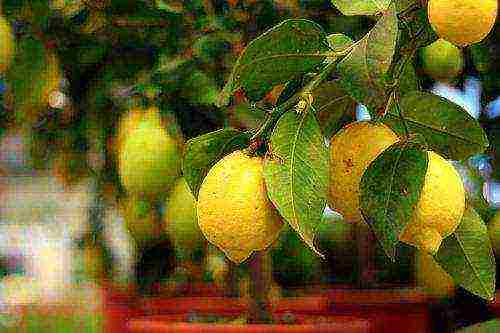
Before buying a lemon tree, you should decide on its variety.
Variety selection criteria
Before purchasing an indoor lemon seedling, you need to determine the purpose of the cultivation. To understand which one you need, the following characteristics will help:
- Fruiting plant.
- Use of fruits for food.
- Shape, color, taste of lemons.
- The presence of thorns on the stem.
- The place where the pot will stand.
- Climate.
If you choose the right variety, it will be easy to care for it. Some varieties of indoor lemons are decorative and do not bear fruit.
Pavlovsky
It is the most suitable lemon for indoor cultivation. The main features of the variety: self-pollination and resistance to lack of sunlight. It grows up to 2 m in height, but with the correct formation of the crown, it will remain small. Young trees give 20–30 fruits during the fruiting period, and adults 50–80 fruits per harvest.
Fruits with a strong but pleasant aroma have almost no seeds. Pavlovsky got its distribution thanks to a rich harvest and unpretentiousness.
The air temperature should not drop below 15 ° C even during wintering, otherwise the plant will shed its leaves. Regular spraying and timely watering are required.
With proper care, it grows 50 cm in height per year.

Pavlovsky lemon gives a good harvest
Meyer's lemon
Meyer's lemon is otherwise called Chinese. This dwarf plant is the result of crossing a lemon and an orange.
Meyer's peculiarity lies in the fruits: they are small and less sour in taste than regular lemons. The peel is thin, yellow-orange, shines beautifully.
Meyer is perfect for indoor cultivation, since the average growth of a shrub is less than 1 m. It bears abundant fruit already in the first year after planting. The flowers resemble large clusters of purple. Needs regular spraying and watering, loves sunlight, so you need to take care of extending daylight hours in winter.
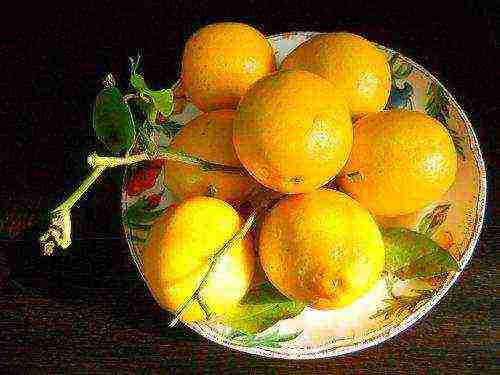
Meyer's lemon - a hybrid of lemon and orange
Maikop
This is the result of the hard work of breeders. For years, scientists have perfected homemade lemon and selected only the best seedlings, so it combines the best of homemade lemon trees. Reaches 2 m in height, adapted for growing in apartments, gives a large harvest. Scientists distinguish between two varieties of the Maikop lemon variety:
- The tree has no part of the trunk between the root collar and the first branch.The branches are horizontal, heavy, drooping as they grow. There are no spines on the trunk and branches. Dark green leaves have an even rim and shine. No more than five flowers per inflorescence. Fruits are elongated with a thin rough skin. Fruit taste is moderately sour.
- Symmetrical crown and branches directed upwards. Spines are absent, leaves are covered with thick dark veins. Flowers are arranged singly. Fruits with a thin skin and small ribs on the surface.
Any of the subspecies of the Maykop lemon gives a large harvest: one tree can bear more than 300 fruits in one year.

Maykop lemon gives many large fruits
Genoa
This popular variety can be easily grown in an apartment and get a stable harvest. The pulp of a ripe lemon is soft and juicy, has a pleasant delicate taste, but the partitions dividing the slices are tough and do not detach well from the pulp. The green-yellow rind is thick and rough, edible. When buying a seedling, you should pay attention to the leaves:
- Bright green color.
- Large, can reach dimensions of 10x6 cm.
- Petioles are wingless and without pubescence.
- Oval, slightly pointed (egg-shaped).
The trees are medium in size and have a beautiful branched crown. There are no thorns on the lower branches and trunk of the tree, but they appear on the upper shoots.
Bears fruit in the fourth year after planting and yields a large harvest. It is sensitive to lack of sunlight, so it is best to place the plant pot on the southern windows.

Genoa lemon grows well at home
Eureka
The lemon variety grown in California has good low temperature tolerance. The fruits are large, with thick skin, and have a pleasant taste. Used in cooking and making cocktails. Ribbing and slight roughness are often found on the surface of the peel. Fruits are light yellow in color with pinkish flesh.
It is easy to determine the type of lemon Eureka by the leaves and buds: the leaves are variegated, and the inflorescences are bright purple. Begins to bear fruit in the first year after planting. It rarely grows more than 2 m, which allows the plant to be grown even in small greenhouses or on a windowsill.
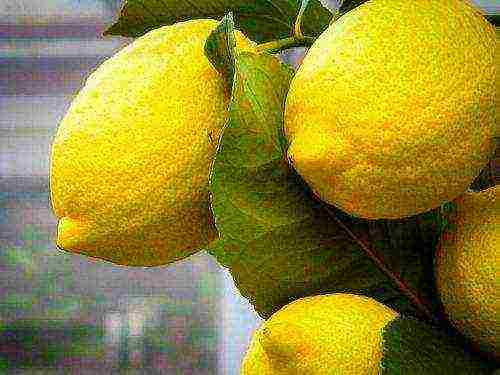
Lemon Eureka - Californian variety
Volcano
Lemon of the Vulkan variety is a hybrid plant obtained by crossing a kumquat and a lemon, and has much in common with the Pavlovsky variety. There are no exact differential signs for determining the grade of the volcano, and under this name in stores you can find lemons of the Turkish subgroup and hybrids of mandarin or kumquat.
Volcano fruits are rarely used for food because of their unpleasant taste, so the plant is decorative in nature.
If the owner needs a plant with a similar look, but edible fruits, then it is worth planting Pavlovsky lemon.

Lemon Volcano produces inedible fruits
Mezensky
It is used as an ornamental variety, since the fruits have an unpleasant bitter-sour taste. The trees are small in size, and if the crown is not formed in time, they have an untidy appearance. The crown grows strongly in width, but not in height.
The Mezen variety has wide leaves, dense in structure, reaching at least 20 cm in size. Inflorescences differ from Turkish varieties in bright purple color and a weak lemon odor. This variety differs from others in the presence of thorns on the trunk and branches.
New Zealand
Scientists have not been able to clearly identify the ancestors of the variety, since it is similar to many citruses. Closest to citron: the plant has spines and narrow winged leaves, large flowers.
Fruits are medium in size and ovoid. Fruit nipple is wide and elongated. The skin is thick and bumpy, ranging from yellow to orange in color. The pulp of the fruit is juicy and very sour, and is loose in structure. There are few seeds in the fruit; more than four seeds per fruit are rare.
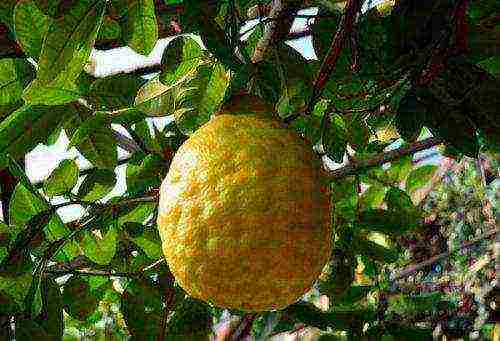
New Zealand lemon produces large fruits with few seeds.
Kiev large-fruited
It is widely known for its high yield. It blooms and bears fruit all year round.The variety is unpretentious, easily adapts to indoor survival.
The beautiful crown is decorated with flowers and fruits all year round. If you form it correctly, you can increase the yield and affect the weight of the fruits: they often weigh about 1 kg. Thin peel and pleasant aroma, there are practically no seeds. The leaves are wide and large, there are no thorns.
Trees can be kept outdoors in summer and brought into the apartment in winter. Kiev large-fruited variety is suitable for greenhouse cultivation in the open field or in small tubs in a greenhouse.
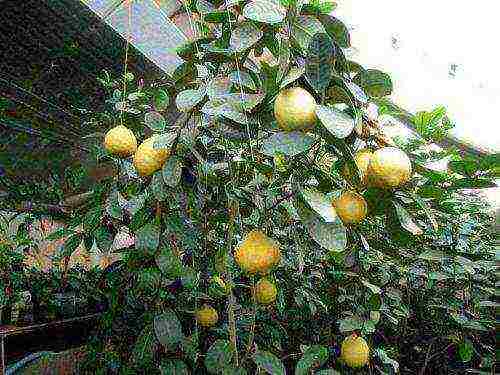
Kiev large-fruited gives lemons up to 1 kg in weight
Ponderosa
Large hybrid form of lemon, obtained by crossing a lemon and a pomelo. Has characteristics characteristic of each culture. Due to the large size of the fruit, flower growers often confuse it with the Kiev large-fruited, but there are differences.
Ponderoza perfectly adapts to growth in apartments, tolerates drought and heat well. Soil oxidation immediately affects the state of the leaves.
The main feature of the variety is the shape of the crown: it is bushy with powerful branches. Leaves are dense and hard, round, small.
Beige flowers with a pleasant aroma are collected both in inflorescences and singly on the tree trunk, therefore, bloom should be monitored so that single flowers do not interfere with the formation of leaves.
Ponderosa grows slowly, so fruiting begins only in the second year after the rooting of the cuttings. The harvest is small but stable.
The fruits are large, I can weigh 1.5 kg. The pulp of the fruit is tender, easily separated from the veins and membranes. The acidity of the pulp is practically absent, but there is a lot of vitamin C. There are many seeds, but the plant reproduces only by cuttings. The rind is dense and fleshy, like a pomelo, lumpy with a bitter aftertaste.
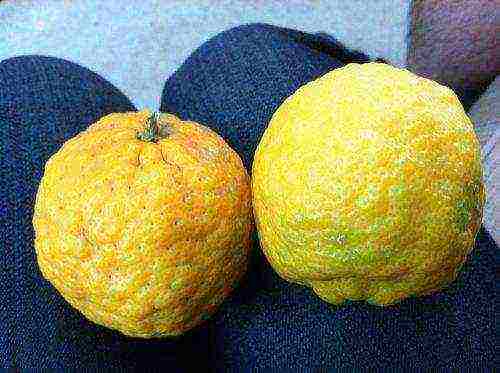
Ponderosa lemon produces very large and tasty fruits.
Lisbon
The most vigorous tree among all varieties of indoor lemons. Gardeners love him no less than others for the yield and beauty of the crown. Lisbon has many large spines that cover the trunk and young shoots. The leaves densely cover all the branches of the tree, have an elongated oblong shape, fleshy. It needs good lighting, so it is necessary to additionally illuminate the tree in winter with fluorescent lamps.
In the second year after rooting, 30–40 fruits are harvested. After a few years, fruiting increases. The crop is harvested 2 times a year: in the middle of winter and at the end of spring. The fruits are oval and bright yellow in color. The skin is thick, covered with deep pores. The pulp is juicy and sour, pitted.
One of the features of Lisbon is the placement of fruits inside the crown, which protects them from the negative effects of various factors.

Lemon Lisbon is a very productive variety
Irkutsk large-fruited lemon
Was withdrawn recently. Features of the variety:
- Unpretentious to care for, but requires a lot of light and fresh air.
- Propagated by cuttings.
- Medium sized tree.
- Fruiting in 2 years after rooting.
- Large tasty fruits.
Fruits ripen for more than six months and grow weighing more than 1 kg. Fruits are oval in shape with a pronounced papilla. The skin is thick, covered with small depressions, and has a yellow-green color. The peel is used for food, the pulp is used for making desserts.

Irkutsk large-fruited lemon bears fruit 2 years after planting
Villafranca
It has a pyramidal shape and powerful branches. Thorns can be seen only on young shoots. The plant is medium-sized, rarely reaches a height of 1.5 meters. The leaves are small, but there are a lot of them on the branches. It blooms with single small flowers or small inflorescences.
Fruits are small in size, round or oval in shape with a pleasant yellow color. Lemons have a smooth surface and reach a mass of no more than 100 g.
The pulp is aromatic and sour. For Russia, this variety is rare, it can be purchased only on order and grown with your own hands from seeds.
Subscribe Be aware of new products on our site
.
Lemon is a plant species of the genus Citrus. There are more than 140 varieties of this plant. New varieties of indoor lemons with improved taste or decorative qualities appear regularly.
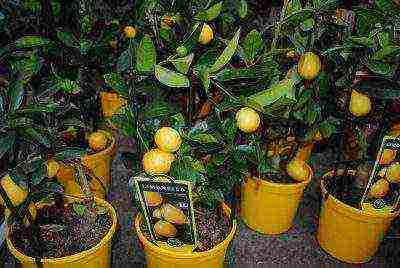
Lemon is a plant species of the genus Citrus. There are special varieties that can be grown at home.
The characteristics of each type of lemon are different, you can choose from them. Which one is suitable for growing in a particular environment. Breeders identify the most popular and unusual hybrids that tolerate indoor conditions perfectly.
Volcano (Citrofortunella Vulcan)
The main feature is endurance and good dry air tolerance.
Vulcan lemon grows up to 1.3 meters, branches very quickly and tolerates crown formation well.
The cultivar was obtained by crossing a kumquat and a lemon. In an apartment it can bloom and bear fruit at the same time.
Lemons ripen in 6 months, 4–5 cm in diameter. There are few seeds, the skin becomes thinner and softer when ripe. The color of the fruit is dark green or yellow-green. The thorns are short, there are few of them, you don't need to pick them off. The leaves are elongated, with a pronounced green tint.
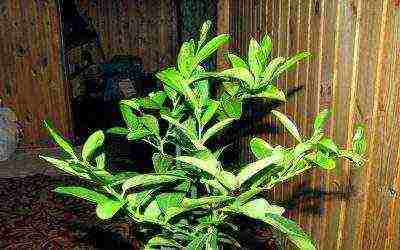
"Volcano" - a variety of lemon, which appeared by crossing kumquat and lemon
Care advice
- Plant only in neutral soil, since the variety is sensitive to acidic environments.
- Regular air humidification, soft light and feeding are required, which will ensure fruiting up to 2 times a year.
- Carry out self-pollination with a brush.
Meyer (Beijing)
This is an unpretentious lemon variety. The tree is not tall, reaches 1.5 m. It blooms and bears fruit several times a year. Photophilous, but does not tolerate excessively bright light. You can accurately determine the variety of lemon by these signs:
- Leaves are deep green, smooth, shiny and dense, with denticles at the edges.
- Flowering begins in early spring.
- The taste of the fruit is slightly acidic, there are almost no seeds. The peel is thin and well separated from the pulp; the fruits are widely used in cooking.
- The crop appears in the 4th year of growth. The ovary matures for 8 months or less with sufficient temperature and watering.
- Lemons are small in size, weigh an average of 70–80 g, and have a short shelf life. It is amenable to propagation by cuttings and layering. The thorns are rarely located, so it is not necessary to cut them off.
Meyer needs to be fed with organic fertilizers from the beginning of March to the end of November 1 time in 2 weeks due to the almost continuous flowering and fruiting. The variety is susceptible to insect attacks and requires regular inspection.
Femminello comune
The best of the six Feminello hybrids, developed in Sicily almost 90 years ago. Able to adapt to surrounding conditions. The tree is medium-sized, up to 1.7 m tall. Resistant to temperature extremes.
It begins to bloom in mid-March, and from October until the next spring, fruits ripen. The period of active growth occurs at the beginning of autumn, therefore, it is fertilized at the end of summer. Italian gardeners mark the variety as a medium-yielding variety, but it has a high palatability.
There are usually few seeds. The rind is wrinkled, dense and thick. The color of the ripe fruit is lime, the juice is sour. Leaves are rounded at the edges, with a serrated fringe, branches with spines of medium length.
Care features
- With the simultaneous ripening of a large number of fruits from one flowering period, it is necessary to pluck the defective ones.
- Fungal infections infect Komune, therefore, excessive moisture in the ground should not be allowed.
Cantonese Red Lemon
Easy to grow at home, reaches 1.4–1.6 meters in height. An adult plant tolerates low temperatures well. Fruiting once a year, flowers are small, with a reddish border. The amount of harvest increases in 3-4 years, and the first time will yield no more than 4-5 fruits.
The taste of lemons is very sour, but the smell is fragrant. The pulp is rich in yellow-orange color, the peel is thin, it is difficult to separate.There are many small thorns on the branches, the leaves are dark green, elongated, pointed.
Cuttings from Cantonese lemon take root well, seed cultivation is not used due to their small size and their number in the fruits.
Kurskiy (Citrus Kursky)
The variety is little known, but among amateurs it is valued for the high aroma of large fruits. Flowering occurs once a year, begins regardless of the season, but most often in spring and autumn. At home, it can grow up to 2 m tall, branches are spreading, with light green foliage.
Fruits reached a weight of 800-900 g, but there are up to 6 of them on a tree. Pear-shaped, bright yellow color. It takes 6-7 years to grow this lemon and wait for fruiting.
Transfers shade, propagates by seed germination and cuttings. It was bred in cold areas, so it does not need high temperatures, a place on the southeast balcony will suit it even in winter.
Doux de Mediterranea
An unusual lemon can combine sweet and sour fruits on the same tree, and some come with sour and sweet slices together. Bred many decades ago in Israel, cultivated in Yugoslavia.
It is better to shape and cut the crown, otherwise the tree will grow up to 2 meters. The foliage is light green, large, with a pointed end. The older the leaf, the darker it becomes. It begins to bloom in the spring, the fruits ripen by the end of autumn. The shape of the fruit is round, with a dense skin.
The pulp is pale yellow, few seeds, only 1-2, but large. Can be planted in a pot at home and in the country. It multiplies easily, but a plant grown from seeds does not bear fruit earlier than 6-7 years.
Tashkent (Uzbek) lemon
This lemon variety attracts with its unusual bright orange fruits. It is shade-tolerant, although it also feels good in the sun. It grows up to 1.8–2 m, but there are also dwarf varieties that slow down the growing season at a height of 1.4–1.5 m.
Flowering begins in spring, it is advisable to cut off the upper points of growth before that, so that the lemon branches in breadth. Leaves are oval, rounded, dark green in color.
The fruits ripen for 6 months, their smell resembles bergamot. The skin is thin and smooth, the flesh has a mild sour taste, there are almost no seeds, so it is propagated by layering and cuttings.
Recommendations for growing varieties
- Self-pollination will be effective if given several days in a row during full bloom.
- The tree is capable of shedding a large amount of ovary if it is not strong enough before fruiting. After the beginning of flowering, feed with organic matter once every 2 weeks - rotted manure or three-year compost.
Melarosa (Citrus limon Mellarosa)
Low-growing lemons, grow exclusively at home. Gardeners are attracted by the unusual smell, reminiscent of bergamot, and decorativeness, with proper care the tree has a lush crown. Small rare cloves are placed on the leaves.

Lemon "Melarosa" attracts everyone with its unusual scent, reminiscent of bergamot
Flowering most often begins in spring, the pink buds smell very nice. The fruits are formed in clusters, ripen in 6-7 months from their appearance. The skin is of medium thickness, yellow when ripe, and the flesh is very juicy and sour in taste. Seeds do not develop.
The taste of these lemons is pleasantly sour; the plant contains a large amount of essential oils. The name comes from Nice, from the similarity of the cross-section of the fruit with the flower. The lemon is flattened, the weight of low-growing varieties does not exceed 100 g, and greenhouse trees - 250 g.
Vanilla (Limone vaniglia)
The vanilla room lemon stands out for its lack of sour taste. A rare variety of lemon has a vanilla aroma, from which it got its name. There are few leaves, they are elongated and pointed, the greenery is dark, the height of the tree rarely exceeds 1.7 meters.
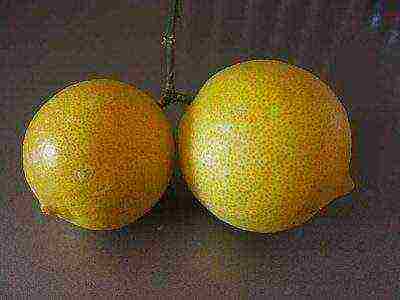
"Vanilla" is a rare kind of lemon, the main feature of which is the absence of sour taste
It takes root in the room and in greenhouses, grown in large containers that can accommodate the root system of a 2.5-meter tree. The shape of ripe lemons is almost perfectly round, the shell is dense and thin, rich yellow, wrinkled in structure. Inside, the flesh of the fruit is whitish in color.
Very often, candied fruits are made from the peel of ripe fruits, which simultaneously have a sour taste and a vanilla aroma. There are few seeds, but they are developed, so you can grow a lemon on your own, but breeders are not sure that a new grown tree will bear fruit.
Determination of the grade of this lemon was carried out at the Institute of Agriculture, Faculty of Agriculture, Catania (Italy). It has been found that it likes the soil with a lot of sand and peat.
Rosso (Limonimedica Pigmentata)
Perfect for growing in a pot. The foliage is dense, narrow, pointed, bright green. The height of the tree can be from 40 cm to 1.8 meters. It is better to form the crown after growing up to 25-30 cm, cutting off the top growth point.
There are many thorns on the branches, it is advisable to cut them off. Flowering begins in early spring, the buds are red or purple, collected in inflorescences.
Fruits can vary in size, their weight ranges from 50 to 200 g. The peel is orange-red, the shade becomes more intense if the fruits ripen in bright sun. The walls of the shell are dense and thick. The taste has sweetish notes.
An unusual variety can be whimsical, so it is better not to violate the requirements:
- Control the low acidity of the earth.
- Spray the crown at least once a week.
- Apply fertilizer during flowering once every 2 weeks.
- Protect from pests.
Buddha's hand
It is widespread in India, China and Japan, began to be cultivated in our latitudes relatively recently, and was able to adapt to the climate.
At home, the tree grows up to 1.5–1.8 m. The foliage is large, more often it is not enough on the tree. It bears fruit once a year, ripening occurs in 6-7 months. At first, the "fingers" are tightly gathered together, but gradually open, causing an association with a human hand.
There is a very rare variety of variegated "Buddha's Hand", its leaves are mostly devoid of pigment, whitish with rare green inclusions. Fruits at the beginning of ripening are striped, but then they acquire the usual yellow color. Lemon has no pulp, as well as seeds. Candied fruits are made from the peel and used in cooking as a seasoning.
Long-term practice has shown that even a beginner can grow the described varieties of indoor lemon trees.
Subscribe Be aware of new products on our site
 Evergreen and perennial lemons are native to the subtropics of Southeast Asia. The plant is hardy and long-term. To get fruits at home, you should strictly follow the care recommendations.
Evergreen and perennial lemons are native to the subtropics of Southeast Asia. The plant is hardy and long-term. To get fruits at home, you should strictly follow the care recommendations.
Even the non-flowering lemon is very decorative thanks to its leathery, shiny leaves. And the flowers that have appeared fill the room with a delicate, but at the same time invigorating aroma. The plant contains essential oils of bactericidal action, volatile vapors ozonize the air, improve mood, and give vitality.
Indoor lemon varieties
For growing at home, medium-sized and undersized varieties are more suitable. In addition to the size and shape of the crown, they differ among themselves in adaptive qualities to environmental conditions, as well as in the size and appearance of the fruits. The most popular varieties of homemade lemon are listed below:
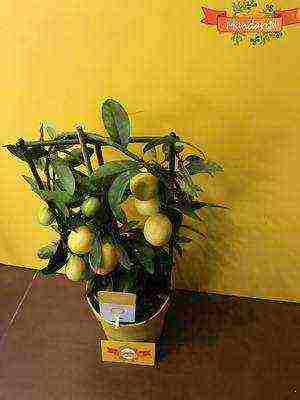 Pavlovsky. This is the fruit of folk selection, it was bred in the village of Pavlovo, which is near Nizhny Novgorod. For almost two centuries, it has been widely grown at home. Trees of this variety grow up to 2 meters, the crown forms a small rounded shape up to 1 meter in diameter. From 20 to 40 fruits grow per year, they have high taste characteristics, often surpassing varieties grown in the open field in this regard.Pavlovsky lemon generally does not contain seeds or they are present in small quantities, but there are specimens with 15 seeds. The peel of the fruit is slightly rough, its width is about 5 mm, and can be eaten. The fruit is approximately 10 cm long, 6 cm in diameter, and weighs 130 g, but some specimens may weigh 500 g.
Pavlovsky. This is the fruit of folk selection, it was bred in the village of Pavlovo, which is near Nizhny Novgorod. For almost two centuries, it has been widely grown at home. Trees of this variety grow up to 2 meters, the crown forms a small rounded shape up to 1 meter in diameter. From 20 to 40 fruits grow per year, they have high taste characteristics, often surpassing varieties grown in the open field in this regard.Pavlovsky lemon generally does not contain seeds or they are present in small quantities, but there are specimens with 15 seeds. The peel of the fruit is slightly rough, its width is about 5 mm, and can be eaten. The fruit is approximately 10 cm long, 6 cm in diameter, and weighs 130 g, but some specimens may weigh 500 g.- Meyer. Another name for this variety is Chinese dwarf. The homeland is China, from where it was first sent to the United States, where its taste was first tested, gaining recognition, the variety continued to collect fans around the world, in particular in Europe, where it gained popularity. According to one version, the variety appeared due to the red-orange Cantonese lemon, another says that it is a natural hybrid of lemon and orange. The plant is small, reaching 1.5 m, it has a dense spherical crown and a small number of thorns. Fruits weighing up to 150 g with a thin bright yellow or orange peel. The pulp is juicy to taste, slightly acidic with a slight bitterness. The variety is fruitful and early maturing.
- Novogruzinsky. The variety was bred recently, it is considered fruitful, the tree is tall, it can grow over 2 meters. The crown is spreading, many thorns are formed. Yellow, round or oval fruits with a thin and shiny skin have a pleasant taste, their weight is up to 150 g. Thanks to good care, the tree is capable of producing 100-200 tasty fruits every year. Moreover, this variety has high adaptive characteristics and is able to grow without requiring special care.
- Lisbon. This variety originated in Portugal, but it was only in Australia that it became widespread. The tree grows quickly reaching 2 meters, it has a dense crown, strong branches and many thorns. The plant bears up to 60 fruits per year, the average weight of each lemon is about 150 g, but sometimes it can reach 500 g. Fruits are of a classic oval shape, the top is slightly beveled, the rind is thick, slightly ribbed, the color is yellow. The pulp has a pleasant sour taste. The variety has good adaptive qualities, which makes it possible to adapt to any conditions of home keeping, even with low air humidity.
- Genoa. Productive variety was bred by Italians, came to us from America. The height of the tree is small - 130 cm. The crown is dense, almost without thorns. The fruits reach 120 g in weight, they have an elongated shape, a rough green-yellow skin. The pulp is juicy, aromatic and pleasant to the taste. The tree bears fruit several times a year, presenting its owners with lemons, which are harvested up to 180 pieces a year.
 Maikopsky. Grows up to 130 meters. A fairly unpretentious variety with a high yield. Fruits weighing up to 170 g, oblong with a barely noticeable thickening in the lower part. The skin of the fruit is ribbed, thin and shiny.
Maikopsky. Grows up to 130 meters. A fairly unpretentious variety with a high yield. Fruits weighing up to 170 g, oblong with a barely noticeable thickening in the lower part. The skin of the fruit is ribbed, thin and shiny.- Anniversary. The variety was obtained as a result of crossing the Novogruzinsky and Tashkent varieties by Uzbek breeders. The hybrid is unpretentious to care for, can grow in a light shade, and is fast-growing. The fruits are large, round, with a thick yellow rind. Weight can reach 600 g.
- Ponderosa. This variety is obtained by natural crossing of lemon and citron. The hybrid has high adaptive qualities - it is resistant to heat and drought. The tree reaches 1.8 m, its crown is spreading. Round or oval fruits with a weight of up to 500 g appear on it, the peel is thick, bright yellow, with a rough texture. The pulp is juicy, pleasantly sour, light green in color. Differs in early maturity, but picky about the composition of the soil.
- Lunari. A hybrid of lemon and papeda bred in Sicily in the 19th century. In appearance - decorative, in fruits - high-yielding. It is named so because it begins to bloom on the new moon. The tree is dwarf, since it reaches only 50 cm, it forms many small thorns. Ovate or oblong-elliptical fruits have a smooth and shiny rind with a rich yellow color. The pulp is slightly juicy, but fragrant greenish-yellow with 10 seeds.
- Villa Frank. The variety was bred by American breeders.It is a tree up to 130 cm in height with a dense crown of emerald green leaves. The branches are almost devoid of thorns. The shape of the fruit is oblong-oval, the color is light yellow, they have a smooth, dense skin, fragrant and pleasant to the taste, in weight they reach 100 g.
- Irkutsk large-fruited. This light-loving variety was recently bred in Russia. The tree is of medium height, its crown does not need to be formed. Its fruits are very large in size - weigh up to 700 g, some samples weigh up to 1.5 kg. The rind is of medium thickness, bumpy to the touch.
- Kursk. Also bred in Russia, obtained as a result of experiments with the Novogruzinsky variety. it has excellent characteristics: shade-tolerant, drought-resistant, fast-growing, relatively cold-resistant, high-yielding. The trees grow up to 180 cm in height. Thin-skinned fruits weigh 130 g.
- Commune. At home in Italy, the variety is very common, gives high yields. A medium-sized plant with a dense crown and a few tiny thorns. Fruits are oval, large in size, almost without seeds. The pulp is juicy, tender, aromatic, and tastes very sour. The rind of medium thickness is slightly uneven.
Other varieties are also popular among indoor lemons:
- New Zealand,
- Tashkent,
- Uralsky,
- Moscow,
- Mezensky.
Growing and caring at home
In order for your houseplant to bloom and then bear fruit, it is important to know how to care for a lemon.
Lighting and temperature
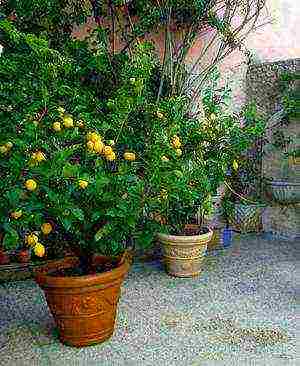 Short light day treeI. A long day has a good effect on growth, but negatively affects fruiting. The plant needs diffused bright light, so the east window is more suitable. It can also be placed in the south, but with shading so that the bright rays do not burn the flower. In order for the leaves to appear evenly, the lemon needs to be turned a little on the windowsill once or twice a month so that the light hits the leaves from the other side. With a lack of light, the leaves slow down growth, and the fruits become very sour.
Short light day treeI. A long day has a good effect on growth, but negatively affects fruiting. The plant needs diffused bright light, so the east window is more suitable. It can also be placed in the south, but with shading so that the bright rays do not burn the flower. In order for the leaves to appear evenly, the lemon needs to be turned a little on the windowsill once or twice a month so that the light hits the leaves from the other side. With a lack of light, the leaves slow down growth, and the fruits become very sour.
In order for the plant to flourish and well, it needs an optimal temperature - 18-20 degrees, for fruit ripening - 22 degrees. In summer, the plant can be taken out into the fresh air, but you should not forget it there, because sudden changes will not do it good.
Winter maintenance is arranged at 15-18 degrees, additional lighting is needed until 12 o'clock in the afternoon, you can skip additional lighting, but the temperature of the content should be reduced to 7-14 degrees. Too high temperature damages the flower, especially if the room has low air humidity. It is good if the soil temperature is identical to the air temperature. Sharp fluctuations are undesirable, which occur when a tree is brought into the room during a cold snap.
Air humidity and watering
The lemon tree loves high humidity. Reacts poorly if it drops, especially in the summer heat. Need daily spraying in summer and during the heating season. Every 10 days, the crown of the plant is abundantly moistened under a warm shower. The air humidity is increased using a wide container filled with water, which is placed next to the plant; you can put the lemon on a tray with wet pebbles or expanded clay.
In summer, homemade lemon is watered abundantly and regularly, about twice a week. The land should not be dry. It should be watered with settled water at room temperature, it can be boiled. In winter they water less often - once a week. Try not to overmoisten the soil.
Fertilization
Lemon care at home includes fertilization. In the summer, they are needed every week, in the winter, once a month is enough, only if the homemade lemon bears fruit. Organic and mineral fertilizers are used. To avoid root burn, top dressing is applied only after watering in an hour or two.
How to make organic feeding:
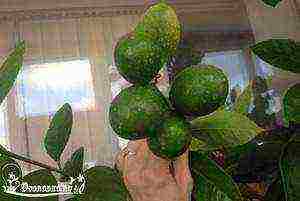 Manure plus water - take each component in part and leave for a week to ferment. Before watering, the solution must be filtered and diluted with water. Horse diluted 1 in 10, cow - 1 in 15.Twice a year, the plant is fertilized with a solution of ferrous sulfate (3 g per liter) and potassium permanganate of a weak (pinkish) consistency.
Manure plus water - take each component in part and leave for a week to ferment. Before watering, the solution must be filtered and diluted with water. Horse diluted 1 in 10, cow - 1 in 15.Twice a year, the plant is fertilized with a solution of ferrous sulfate (3 g per liter) and potassium permanganate of a weak (pinkish) consistency.
Mineral dressing for citrus fruits is bought in the store and is carried out according to the instructions. For example, a Citrus mixture, which contains N, P, K in a ratio of 14:16:18. Also, in addition to this, a complex of trace elements is needed.
Transfer
Plants up to 3 years old need an annual transplant in the spring. Transplanting should be done carefully so as not to damage the root system. It is better to do this using the method transshipment with partial removal of the old clod of earth. Adult specimens are replanted every 3 years at the beginning of the growing season. The procedure is not performed during flowering or fruiting. The size of the pot should not exceed 15 cm. At the bottom, you need to put 2-3 cm of drainage from expanded clay or sand with charcoal.
The soil needs loose and nutritious, neutral reaction, the composition is as follows:
- leafy land with turf - 4 parts,
- in terms of sand and manure,
- ash - 1 tbsp,
If it is not possible to compose the substrate on your own, use a special soil - for citrus fruits.
Crown formation
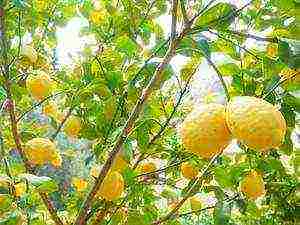 Growing indoor lemon is not complete without pruning the crown. This is best done in the spring before growing. The formation of the crown is carried out in the form of a bush on a low trunk (no more than 18 cm). The shoots are pinched, leaving about 5 leaves.
Growing indoor lemon is not complete without pruning the crown. This is best done in the spring before growing. The formation of the crown is carried out in the form of a bush on a low trunk (no more than 18 cm). The shoots are pinched, leaving about 5 leaves.
The fruits are formed on a branched plant. Most varieties are tied on branches of 4-5 orders of magnitude. Only the Meyer variety can lay fruits on the branches of 2-3 orders of magnitude.
If the crown is properly formed, then this shortens the time for the beginning of flowering: a lemon can please with flowers already 2-3 years after planting. Number of colors needed regulate, if this is not done, the plant will deplete the plant. The first flowering should be scarce, for this you need to remove half of the flowers. From the resulting ovary, you need to leave only 3 fruits. For the second year and subsequent ones, one lemon is added.
Flowering and harvesting
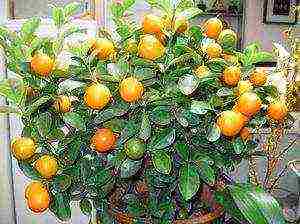 The lemon plant, depending on the variety, can bear fruit from one to four times a year. Flowers of different sex form ovaries without cross-pollination. The bud develops in about 5 weeks, blooms for about 2 months. From the laying of the fruit to ripening, it takes about 200 days, it depends on the lighting and temperature. Flowering with fruiting when growing lemon is allowed only if there is a sufficient number of leaves. At least ten developed leaves are needed per fruit.
The lemon plant, depending on the variety, can bear fruit from one to four times a year. Flowers of different sex form ovaries without cross-pollination. The bud develops in about 5 weeks, blooms for about 2 months. From the laying of the fruit to ripening, it takes about 200 days, it depends on the lighting and temperature. Flowering with fruiting when growing lemon is allowed only if there is a sufficient number of leaves. At least ten developed leaves are needed per fruit.
Full ripening of the fruit is indicated by an intense golden color. At this moment they are ripped off. If this is not done, they will continue to develop on the branches without dropping, but their quality will deteriorate.
If you properly care for the plant and create all the conditions for it, it can bear fruit throughout the year, on a lemon there can be buds, flowers and fruits at the same time.
Thus, homemade lemon, with good care and attentive attitude, is able to respond to love with beautiful fragrant fruits.
>


